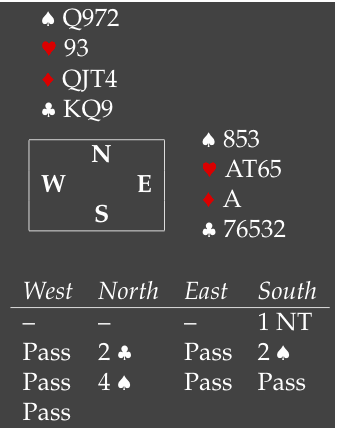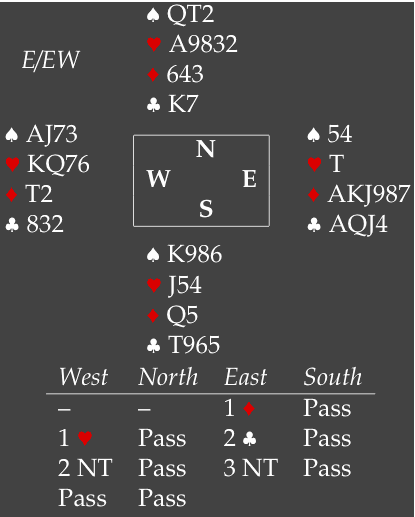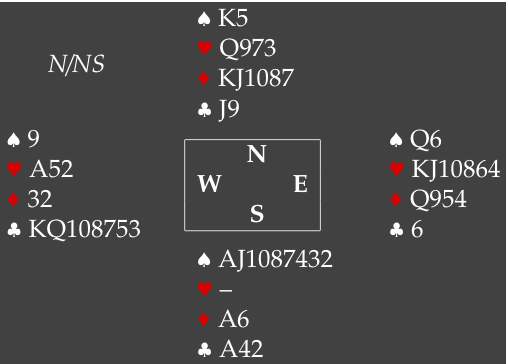The theme of the hands I played and watched last week seemed to be “oops”. You know, you make the normal looking play only to regret it seconds later when you realize that there was a much better card available.

A simple example to get started. You are defending 4♠ on the ♥K lead from partner, small by declarer and you play a routine, encouraging ♥10 (or 5, or whatever you use), right?
Did you say yes?
Well, you have just missed the point, too. There is a 100% line to defeat 4♠: overtake, cash the ♦A and return a high heart. Partner will probably figure out that the ♦A was a singleton.
This one was probably too simple as a problem, though in a 8 table field, 3 players actually missed it, time for some more complex and interesting stuff.

The second hand came up at my table last week. You are in 3NT and get the ♠2 lead, 3rd and 5th. You win and play the ♦10, intending to run it and repeat the diamond finesse if needed. The finesse is off, however, south returns a spade and north cashes ♠QT and the ♥A followed by a diamond. Locked in dummy, you have to concede a club for down 1. Oops...
Yes, oops, declarer should have made this had she looked at the hand a bit longer. The routine play in the diamond suit is to run the ♦10 intending to repeat the diamond finesse as needed. But is that the right play here?
No, if south has the ♦Q, you will need a club finesse as well. (Trying to set up a heart won’t work, the defense can lock you in dummy as above.) That requires an entry in the west hand and the only one potentially available is the ♦10. So, keep that card and lead a low diamond in trick 2 instead.
If the finesse is off, south will probably return a spade. Cover that spade, north can never cash the entire suit without setting up the ♠J. The ♦10 is your entry to take a club finesse. And what if the diamond finesse is on? Cash the ♦AK next, if the diamonds split, play a heart, setting up a 9th trick before they have their 5. If the diamonds don’t split, concede a diamond to north. Whatever he does, will help you create a 9th trick. In the worst case, you have to rely in the club finesse you needed in the first place.
Bottom line, the ♦10 is the right card if you have to play the suit in isolation, but it isn’t the right card in the context of the whole hand.

Finally, this hand, it came up in the Vanderbilt semi-finals last Saturday. A world class declarer ended up in 6♠ after a weak 2♥ from east and preemptive raise by west to 5♥, after declarer showed a strong hand with spades. On the lead of the ♥A, the routine line for a 12th trick seems to be to go for a club ruff. So, at trick 2, a small club was led, won by west. Well, there was a club ruff, only the defense scored it on trick 3, not declarer on trick 4 as planned. Oops...
It looks as if declarer picked a logical line but it isn’t by far the best. Obviously, declarer never has a chance on this line when east has only a singleton club, but with a doubleton club in east, declarer isn’t home either. West wins the ♣Q and returns the ♣K to declarer’s ace. If south decides to believe any count signals that EW give, he has to ruff a club with the ♠K, then take a spade finesse on the way back. That works here, but you don’t like to go down with ♠Qx in south. Note that the auction suggests bad breaks, EW won’t bid 2♥ and 5♥ without a lot of shape.
Slightly better is to cash the ♣A in trick 2. At least you now see that the clubs split 7-1 and can ruff the second one high. The 2♥ bid also suggests a 2=6=4=1 shape in east, making the spade finesse a favorite. With clubs 6-2, it still requires guessing.
There is an even better line: play on diamonds. Win the opening lead, play the ♠A, ♦A, then take a diamond finesse. If it works, claim, if it is off, ruff the return with the ♠J and claim again. You will only go down with specifically with 2-3-2-6 with exactly ♠Qx in west.
Actually, there is also a nice line to make 7♠, as was demonstrated by Joe Grue in the other semi-final. He was helped by a fit showing club bid from west, suggesting 3♥ and 6+♣. He also won the opening lead, cashed the ♠A but now continued with ♦AK and the ♦J, discarding a club and playing east for the long diamonds. West already showed 9+ cards in ♥ and ♣, so this is a heavy favorite to win. All in all, nicely played, with optimal use of all information available from the auction.

